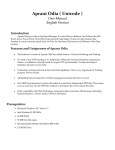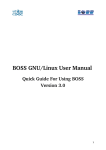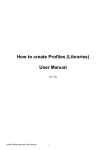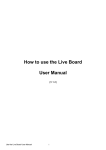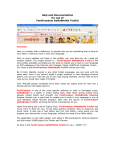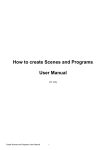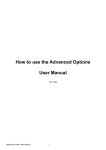Download How to create Profiles (Libraries) User Manual
Transcript
How to create Profiles (Libraries) User Manual (V.1.2) Create Profiles (libraries) User Manual 1 Summary: P. 2 P. 3 P. 3 P. 4 P. 6 P. 9 P. 10 Index of Pictures Opening the Profile Editor Creating a Profile Creating and adding Channels Creating Presets on the Channels Saving, loading and modifying Profiles Glossary of Terms Index of Picture: P.3 P.3 P.4 P.5 P.6 P.7 P.8 2D tool ribbon Profile Editor page Commun Channel list Pan Tilt and 16 bit channels Preset window for Gobo channels New preset for shutter channel Color preset Create Profiles (libraries) User Manual 2 This chapter describes how to easily create a fixture Profile with the software in a very short time. The Profile Editor is included in the software making it is very easy to access the Editor and create or update Profiles. You must start the software before you begin to create the Profile. Opening the Profile Editor After starting up the software, you must click on the Add button to open the Profile Editor. The Add function is the first button on the left of the 2D tool ribbon. 2D tool ribbon The Patch Editor will appear and you can choose between the Patch or Profile pages. Select the Profile page to use the Profile Editor. Profile Editor page Create Profiles (libraries) User Manual 3 Creating a Profile Enter your Profile name in the Name field. On the right hand side you will see a bar containing a square, circle, hexagon and triangle. Choose the shape of the beam that you wish to be displayed for the 2D view in the Editor mode (default mode when you start the software). • The Nb Channels and the Light Beam Count will be automatically updated. Alternatively, you can change the Light Beams Count if you know how many beams your fixture uses. • Choose a picture for your fixture (depending on the kind of fixture you want to create) from LED, Trad, Scan, M.H, Laser, Other. This picture will be displayed in the Editor mode. Having the appropriate picture is very important because it will be easier to graphically distinguish each fixture you work with and it will also improve the selection process. • • Creating and adding Channels Choose the channels that you want to add to your Profile. Drag and drop channels from the list of common channels to the area under the list. These channels will then appear in this area and the Nb Channels will increase. You can change the order of the channels by dragging and dropping them. Commun Channel list It is possible to use the channel options to the left of the channel area. You can Add, Remove, Update, Copy or Past a channel. You must select one or several channels before using these options. Create Profiles (libraries) User Manual 4 This example shows 1 Dimmer channel, 1 RGB (Red, Green, Blue) and 1 Shutter: Example of channels List of possible Channels The channel list gives all the common possibilities available for fixtures : DIMMER, SHUTTER, RGB, CMY, WHITE/AMBER, DIMMER COLOR, SPEED, PAN TILT, IRIS, FOCUS, ZOOM, GOBO WHEEL, GOBO WHEEL ROTATION, GOBO ROTATION, GOBO INDEX, GOBO SHAKE, COLOR WHEEL, COLOR WHEEL ROTATION, PRISM, PRISM ROTATION, PRISM INDEX, UNDEFINE. Channel Shutter This channel is mainly used for the Strobe function and preset but it can also include and manage a dimmer function and preset. Create Profiles (libraries) User Manual 5 16 Bit on the Channels All channels can be used under 16 bit. The 16 bit function is an extra channel that is used to increase the accuracy of the dimming. Instead of 255 available values per channel, you have 65 535 available values for 2 channels. Select the 16 bit option on the channel then a second channel will appear. You can drag and drop the channel to change its position in the list. This example gives the Pan and Tilt under 16 bits: Pan Tilt and 16 bit channels Create Profiles (libraries) User Manual 6 Creating Presets on the Channels It is possible to add and create some presets for a channel. The preset is a DMX range or part of the 255 values available in the channels. For example a preset can inscript the channel values from 20 to 51 for a specific function. The presets are important and useful, because they allow you to reach a DMX value quickly. With good preset settings you will be able to program a show much faster. Some channels like PAN, TILT, RGB, CMY, White/Amber can not receive presets. These functions will request the 255 values every time and the software gives a dedicated function (Color Palette, Pan/Tilt control windows, etc...). Merely dragging and dropping a specific channel in to the area is sufficient. Click on the ADD button (the blue spanner & screwdriver located under the 16 bit option) of a channel to create the presets. After a few seconds the preset window will appear. Preset window for Gobo channels Create Profiles (libraries) User Manual 7 The preset window is divided in to 2 areas, left and right. The left hand section shows all the available presets contained in the software. The right hand section is for the actual presets that you select for that channel. Select the family of preset that you require from the left hand section and drag and drop the chosen preset in to the right hand section. A new preset will appear. New preset for shutter channel The first preset is located on the bottom of the right hand section (you may need to scroll down to see it) If you look carefully at each preset, you can change the name of the preset, choose the end, default and start DMX values and assign a DMX value as default. • The first value is the DMX value that starts the preset. • The end value is the DMX value that stops the preset. • The default value is the DMX values that uses the software to reach the preset. Create Profiles (libraries) User Manual 8 Default preset Tick the DEFAULT box to assign the default value of the preset as the default DMX value of the channel. Each channel can have only one default value. They are for use with the option Set Default DMX Levels and with the program effect generator. For example, if you wish to turn on your light, you must open the shutter, possibly the Iris, and increase the dimmer. The default value will help you to do it in one click by accessing the default channel DMX values directly. It is important to set up good default DMX values for each channel. You can assign a new picture to a preset. Click on the preset image in the right hand section and select the new picture that you wish to use by clicking on it in the software data base on the left. Click on the Update button (blue arrow above the right hand section) to assign the new picture to the existing preset of the channel. Continue adding the desired presets by dragging and dropping them in to the right hand section and choosing the end and start DMX values for all of them. The list you have created will be used and displayed on the channels of the Editor mode. Some functions of the Live Board will also use the preset values. Gobo and other presets The GOBO family is used to create gobo presets for the channel. With a Gobo Wheel channel, this family will appear automatically. The software gives you several families, they depend on the type of channel used in the list of channels and work exactly the same as the gobo presets. • Select the family of preset that you need. • Select a gobo image or another image from the list as before. • Drag and drop the picture from the left hand area to the right hand preset area. • Choose the start, and default DMX values of the preset. Create Profiles (libraries) User Manual 9 Color preset This family of presets is used to create Color presets for the channel. With a Color Wheel channel, this family will appear automatically. Color preset At the top of the window, there is a palette you can use to change the RGB values of your color. Under this palette there is a list of all 42 colors available. They can all be modified using the palette. • Select one of the colors in the list. • Choose or modify the selected color by clicking on different colors in the palette • Drag and drop you color from the list to the right hand area • A new color preset will appear • You can then rename it and change the DMX values of this preset Create Profiles (libraries) User Manual 10 Dual color preset The Dual color function is available within the color family preset. There are 2 possible options: Half Color and Half Color Auto. You can choose 2 different colors with the Half Color option. Select the first color square and change it using the palette then do likewise for the second color. Drag and drop the half color in the right hand preset area. When you drag and drop it in the right hand area, the Half Color Auto option will automatically choose the color for you. This option will save your time, simply create all the colors first and use the Half Color Auto between each color. Saving, loading and modifying Profiles At the top of the Profile Editor window, 3 options are available. Simply use the option you need when necessary: Create a new Profile, Open an existing Profile, Save a Profile as. All the Profiles are saved in the Profile folder of the software installation directory. We recommend you save all your new Profiles in the same directory and create a personal folder to save them all in. We also recommend keeping a backup of all your Profiles in case you reinstall your system or encounter hard drive failure. We would also like to invite you to exchange your Profiles and send them to your dealer or distributor to keep our database updated regularly. Including and using Profiles in the project The Profile you have just created can be used directly in the current project. Just open the Patch window and refer to the user manual How To Patch DMX Profile. Now you are able to create your own Profile. Refer to the user manual of the lighting equipment for the available presets, then you can use the Profile Editor to add channels and presets and customize your Profile. Create Profiles (libraries) User Manual 11 Glossary of Terms DMX512: DMX is a shortened form of Digital MultipleX. It describes a standard method of data transmission that allows the interconnection of lighting control equipment by different manufacturers. The DMX512 protocol was developed in 1986 by a committee of the USITT (United States Institute for Theater Technology) to provide a standard interface with which to control dimmers from lighting consoles. It allows a maximum of 512 channels per DMX line and each channel can reach 255 levels. Channels have a dimming function with 255 values. Fixture: A predefined DMX device containing channels. It is used for any type of lighting device like spot, moving head, scanners, lasers, follow spot or visual effect devices like smoke machines. Channel: A DMX or analogue output. It can use 255 digital values. Also known as DMX channel, which, for the purposes of this guide, is synonymous with DMX address. Any DMX light show, including shows designed with the software, sends data to the lights using up to 512 separate channels. The DMX Channel Number assigned to a light in the software must match the DMX address on the light itself. Since each light uses three channels, (one each for red, green, and blue,) the DMX Channel number indicates the first of three consecutive DMX channels that the light receives. Address: A digital number from 1 to 512 for a channel or a fixture. Address numbers define which channel is concerned. Universe: A group of 512 DMX channels, or the group of three analogue channels on the rear of the product. Profile: A overview of the fixture channels functions and descriptions. The Profile shows all the channel presets and channel numbers and defines the fixture type. Profile Editor: A tool to create new Profiles and give the user more control options. Patch Editor: A tool to assign different channels to the fixtures and create matrix configurations. It is composed of several universes with 512 channels each. RGB: Acronym for red, green, blue. In the RGB color model, all colors are produced by combining various levels of red, green, and blue. The software includes an RGB color picker. A lighting feature for Red Green Blue color. Step : A target state for one or more channels which will fade to the new values over a preset time. More than one scene may be active simultaneously. Scene or Program : A number of steps, recalled automatically over time. More than one sequence may be running simultaneously. Create Profiles (libraries) User Manual 12 Fade: Fade effect is a smooth transition, back and forth, between two colors. The effect slowly increases the intensity of one color of light while simultaneously reducing the intensity of the other color. Triggers : An input in to the system that recalls a scene or sequence. Triggers include user-mode buttons, the real-time-clock and the three configurable inputs on the rear of the product. Brightness / Dimmer: Also known as intensity or luminance. A measure of the rate of flow of light energy (luminous flux) per unit area leaving a surface in a particular direction. A lighting feature to modify the intensity of the lamp. Color: The impact of light source colors is determined by the combination of three factors: hue, saturation, and luminance. Hue indicates whether a color looks red, orange, yellow, green, blue, violet, etc. Saturation represents how pure a color is, and luminance (brightness) identifies how strong the color is. The software includes a color picker to help you choose from over 16.7 million possible colors. Strobe: The Strobe effect produces a series of light flashes. Very short, bright flashes can produce a “stop action” effect, where actions seem intermittent. Strobe rate Refers to the number of flashes per second, or how many times in one second the light is illuminated. Drag and Drop: This action allows you to move objects to a different part of the software. Click on the object you wish to move then, holding down the button, move the mouse to a different area to bring the object to this place, then release the button to drop the object. Shutter: A lighting feature that quickly opens or closes the light beam. Preset: A DMX range or part of the 255 values available in the channels. For example a preset can inscribe the channel values from 20 to 51 with a specific function. Default Preset: This preset is used to setup a default level for the channels. One default preset per channel is allowed. If no default preset is defined with the Profile Editor, the software will use the value 0 as its default preset. Create Profiles (libraries) User Manual 13













